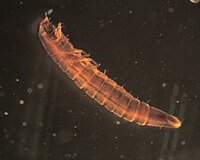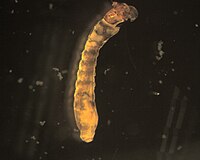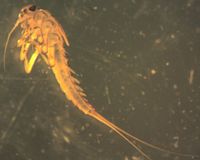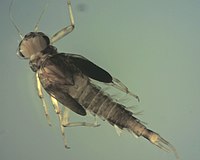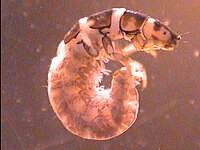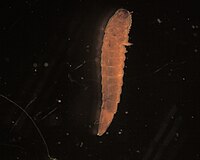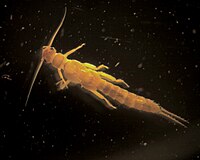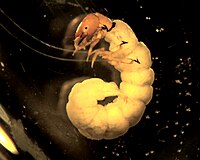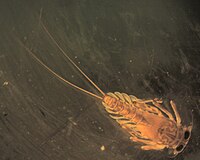Vermont EPSCoR's Streams Project; A Teacher Collaboration on WikiEducator
Openly shared content, practices, and developing resources from Vermont EPSCoR's Streams Project. Join this collaboration and make a difference!
 Stevens Brook |
|---|
|
| Stream code: | LCD_StvBrk_574 |
| Basin: | Lake Champlain Direct |
| State or Province: | Vermont |
| Country: | USA |
| Latitude: | 44.806977 |
| Longitude: | -73.083787 |
| School: | Bellows Free Academy St. Albans |
The following are the most common invertebrates collected from this stream site.
Chironomidae
- Order
- Diptera
- Family
- Chironomidae
- Common name
- Nonbiting midge
- Tied fly
- Griffith's Gnat
Midge larvae tend to be the most common macroinvertebrate at our sites. As with other Diptera, there are no true jointed legs. Chironomidae do have a pair of prolegs at each end and preserved individuals tend to curl into a 'C'. Identification past family requires slide-mounted heads. We have seen philopotamid caddisflies misidentified with the chironomids and we suspect that that happens when samples are being sorted from trays. Under a microscope, six prominent legs can be seen on members of the caddisfly family Philopotamidae.
More information on Philopotamidae.
Stenelmis
- Order
- Coleoptera
- Family
- Elmidae
- Genus
- Stenelmis
The larvae of
Stenelmis, as in
Ordobrevia, have a sternum on the ventral side of the pronotum. The main difference between the two genera is in the antennae the second segment is less than twice as long as the first in
Stenelmis.
The adult Stenelmis has a clear separation between the thorax and abdomen as well as a more distinctly separate head as compared to other genera.
Click here to see pictures of the sternum and
antennae-
Simuliidae
- Order
- Diptera
- Family
- Simuliidae
Simuliidae appear rather like bowling pins with heads. Relatively speaking, we collect few members of this family and have we have not identified them past family at this point.
Click here for a close up image of the heads.
Baetis
- Order
- Ephemeroptera
- Family
- Baetidae
- Genus
- Baetis
- Common name
- The Little Olive
- Tied fly
- Sawyer Pheasant Tail Nymph
This mayfly has three "tails" and a unique head shape. Its gills are oval shaped and insert dorsally. More mature nymphs have long, dark wing pads.
Image of the long, dark wing pads.
Acerpenna
- Order
- Ephemeroptera
- Family
- Baetidae
- Genus
- Acerpenna
- Common name
- Tiny blue-winged olive
This genus is can be identified by the costal process, or projection, distal to the hind wing pad. Gill 7 is slender and may be pointed at the end. The antennal scape and pedicel have a few scattered setae (hairs).
Image of the antennal scape. A ventral view can be seen here.
Ceratopsyche
- Order
- Trichoptera
- Family
- Hydropsychidae
- Genus
- Ceratopsyche
Ceratopsyche has a
forked foretrochantin. The foretrochantin is the projection at the uppermost portion of the foreleg. The leg may need to be pulled away from the body to expose this feature.
Ceratopsyche have a
large pair of sclerites underneath the prosternum. Note: the large single sclerite is the prosternal plate. Biologists have gone back and forth between lumping this genus into
Hydropsyche and splitting it back out. ITIS currently lists it as a genus (Feb 2013) but we are aware of a recent paper that lumped it under
Hydropsyche.
Optioservus
- Order
- Coleoptera
- Family
- Elmidae
- Genus
- Optioservus
The larvae of
Optioservus have open coxae, as determined by the straight definition between segments on the ventral side of the pronotum.
The adult Optioservus have a compact appearance, especially the head and thorax. There are also dorsal ridges and a characteristic diamond-shaped sutellum observable in the dorsal view.
Images of the straight definition between segments, the dorsal ridgesand the diamond-shaped scutellum.
Alloperla
- Order
- Plecoptera
- Family
- Chloroperlidae
- Genus
- Alloperla
Chloroperlids stoneflies are quite slender relative to most other stoneflies. The adults are green but this trait does not show up in the nymphs. Chloroperlids from this genus are characterized by a fringe of intrasegmental setae on their cerci.
Image of the intrasegmental setae.
Dolophilodes
- Order
- Trichoptera
- Family
- Philopotamidae
- Genus
- Dolophilodes
Epeorus
- Order
- Ephemeroptera
- Family
- Heptageniidae
- Genus
- Epeorus
- Common name
- The Quill Gordon
- Tied fly
- Quill Gordon
This is the only Heptageniidae genus present in this area with two tails!
Hydropsyche
- Order
- Trichoptera
- Family
- Hydropsychidae
- Genus
- Hydropsyche
- Common name
- spotted caddis
- Tied fly
- dark cahill
Hydropsyche are net-spinning caddisflies and share most characteristics with other members of the Hydropsychidae, including the
Ceratopsyche.
Hydropsyche are distinguished from
Ceratopsyche by the presence of scale hairs and minute spines on the three most posterior abdominal segments.
More information on the Ceratopsyche can be found here.
Image of the sclerites in the intersegmental folds.
We also find Helichus Curculionidae at this site.


